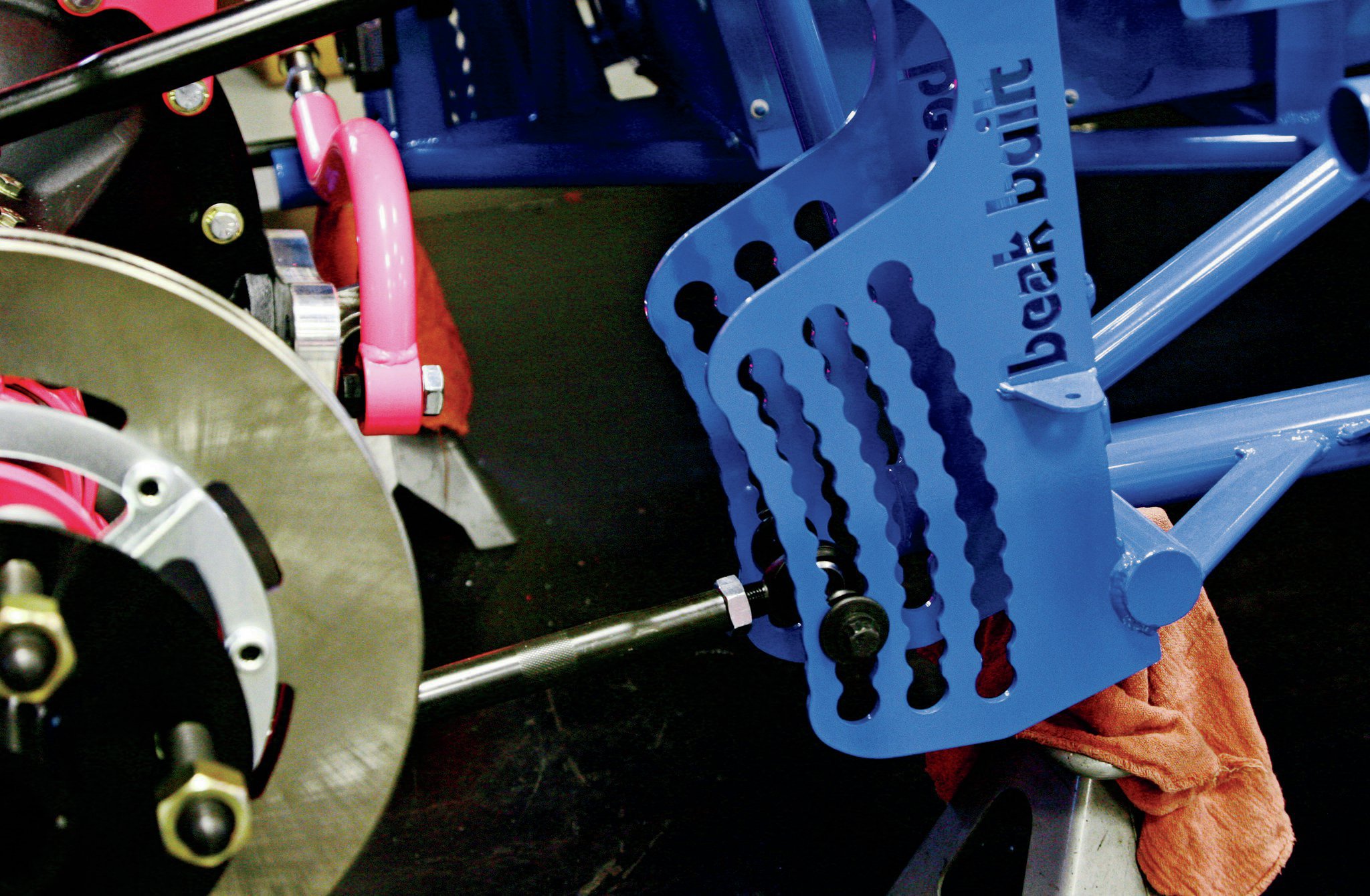As racers have searched for more rear traction on dirt tracks, four link rear suspensions have increased in popularity.
They were originally developed by drag racers to increase forward bite, then adopted by dirt late model and modified racers where they have become common. As teams have experimented with the dynamics of four link, they have increased link inclination for greater effects. Doing so increases the vertical loads on the rear tires during acceleration, and generally increases the chassis’ rear steer as it rolls.
We may be approaching the practical limit to this trend, especially as teams discover one or both of their rear springs completely unload under acceleration and/or cornering. Teams are also finding they need suspension droop travel limiters to keep rear axles under their cars.
Intentionally bottoming shocks using chains to limit travel or allowing the rear axle to contact the frame on under-rail chassis upsets rear tire grip.
A couple of points about load transfer and suspension anti-squat.
Total weight (vertical load) transferred from the front to the rear as a car accelerates depends solely upon the car’s total weight, its wheelbase, the instantaneous height of its center of gravity and the amount of forward acceleration. Nothing else makes a difference in the amount of rearward weight transfer.
So what is it about a four-link suspension that allows it produce increased forward grip? The answer lies in the dynamics of the suspension links and their respective inclinations, but not for the reasons most racers think.
The upward inclination of rear suspension links produces jacking forces whose vertical components press the chassis upward at their mounts when the car accelerates.
These upward chassis forces are known as an anti-squat since they resist the natural tendency of the rear suspension to compress, or squat, during forward acceleration. Picture the rear axle wedging under the chassis as it is forced forward under acceleration. The anti-squat forces are balanced by equal but opposite vertical downward forces produced where the inclined links connect to the rear axle.
While the increased traction produced by four link suspensions is generally attributed to those vertical axle forces, that explanation is incomplete since it totally ignores something else happening at the same time.
A chassis with 100% anti-squat will exactly resist the natural tendency of the rear suspension to squat down due to weight transfer under acceleration. A car with less anti-squat will compress its rear suspension under acceleration. An accelerating car with more than 100% anti-squat will actually pitch the rear up due to the suspension’s jacking forces. Rising the rear up is what dirt cars with four-link rear suspensions are designed to do under acceleration.
Since a chassis with more than 100% anti-squat rises under acceleration, its upward motion actually unloads the rear springs. However, as the vertical suspension loads passing through the rear springs is reduced, the vertical components of the jacking forces passing through the suspension links is increased by exactly the same amount. There is no net gain in downforce.
Side-to-side suspension asymmetries cause changes in individual rear wheel loads produced by jacking forces. This creates changes in dynamic cross weight and is one of the main reasons for using asymmetries in four link suspensions. But the total vertical rear axle load will not change. Anti-squat geometry simply reduces some, or all, of the rear axle spring forces and passes them to the axle through the rear links.
Since this is true, how can four link suspensions produce so much more forward traction? What else is going on?
When anti-squat exceeds 100%, the car’s forward acceleration forces the back of the chassis to rise. As the chassis rises, so does its center of gravity and the total amount of weight transferred to the rear axle increases proportionately. It is the increased amount of weight transfer to the rear axle due to the car’s rising center of gravity that increases vertical tire forces and thus forward traction. A car whose center of gravity is forced to rise from 18” to 22” during acceleration will increase the weight transferred to the rear axle load by over 20% compared to a chassis that does not rise.
In extreme cases, jacking forces can be so great that one or both rear springs become completely unloaded. In that case, all vertical tire forces are due to jacking effects. At that point the rear tires will be much more heavily loaded that is possible with the weight of the car alone but the gain is likely unstable.
To be clear: four-link suspension linkages do not produce any additional rear axle forces as such, but they can increase chassis ride height during acceleration which results in additional dynamic weight transfer.
Cars whose rears squat down under acceleration (as most street cars do) are reducing rear weight transfer compared to cars that do not squat even though they compress their rear springs more.
Even suspensionless top fuel dragsters are set up to lift in the rear under acceleration.
So far we have been talking about straight-line acceleration, but dirt track cars with very large amounts of anti-squat can also have an advantage when they are cornering under power.
Lateral weight transfer in turning is determined by exactly the same equation that applies during straight line acceleration except that wheel base length is replaced by track width and forward acceleration is replaced by cornering acceleration. So changes in the height of the car’s center of gravity produced by anti-squat forces have similar effects on lateral load transfer, but only when the car is jacked up under power. The harder the driver accelerates, the more the center of gravity rises so more weight transfers to the outside tires. That is part of why dirt cars are able to corner so fast when they appear to be so jacked out of shape. Fortunately, jacked out of shape is popular with racing’s fans which is one major reason why dirt track racing draws big crowds.
Anti-squat’s gains have limits. These forces reverse under braking and stop abruptly when the suspension runs out of travel. In such case, two things generally happen in rapid succession.
The combination of jacking forces and chassis roll may unload the left rear spring entirely. When this occurs, the left rear tire will be loaded only by jacking forces. That reduces the rear suspension’s roll stiffness by a factor of about two which momentarily tightens the car up. If the chassis continues to rise and roll, the axle may run out of travel on the left side altogether.
When that happens, no matter if by limited shock travel, frame rail contact or the use of travel limiting chains, all of the load at the left rear abruptly shifts to the right and it happens almost instantly. The car will then snap loose. Other than adding some compliance to the travel limits which would make the effect less abrupt, I am unaware of a solution to this problem other than limiting anti-squat, increasing roll stiffness or increasing suspension travel.
Only increased suspension’s travel will not have other adverse affects on traction. Therefore, that seems to be the correct direction.
Working with jacking forces for better performance is worthwhile but when they become high enough to unload rear springs, or worse yet, bottom out the rear suspension, the car will be very unpredictable to drive.
Story by Doug Gore

